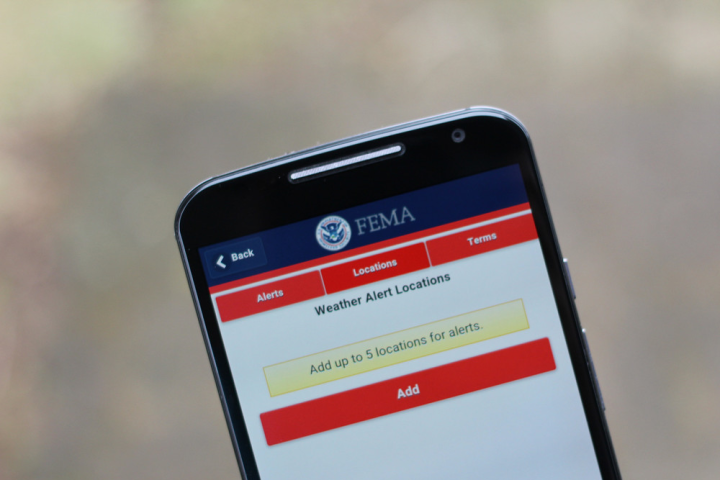
This is something the Federal Emergency Management Agency (FEMA) hopes to change. The agency has launched an updated app for Android, iOS, and BlackBerry that provides a means of documenting disaster zones for first responders.
The eponymous FEMA app isn’t new by any stretch — it debuted on Android way back in 2011. But the new version dramatically simplifies and streamlines many of its features and functions, a representative for the agency told Digital Trends.
You can opt to receive alerts like advisories from the National Weather Service, search a database of tips that’ll prep you to weather “more than 20” man-made and natural hazards, and download templates that can help suss out a readiness plan. And it has a checklist of preparedness tips “laid out nicely,” the spokesperson said, with “boxes you can check as you complete them.”
But the update’s headlining addition is what FEMA calls “mobile disaster photography.” At its most basic, it’s a crowdsourced stream of photos from hazardous areas such as buildings toppled by earthquakes, neighborhoods torn apart by tornadoes, and streets overrun by rivers.
After you snap a pic, you’re prompted to choose from a selection of categories including “flood,” “thunderstorms,” and “wildfire.” Then, after you’ve assigned a date and location, the app uploads your material to FEMA’s cloud storage. “When you take a photo of a disaster that’s happening in your area, first responders have access to that database,” the spokesperson said. “It gives first responders a clear picture of what it looks like out there.”
The update’s timing — on the eve of hurricane season — is no coincidence. Two-thirds of American households lack plans for any sort of natural disaster, according to the agency, but a vast majority — 68 percent — own a smartphone. It’s an invaluable opportunity to “increase readiness,” the spokesperson said, and potentially even save lives. FEMA’s already making headway, apparently: nearly “half a million Americans” have downloaded the app, the agency said in a statement.
Photo sharing isn’t the only thing the FEMA app can do. It also provides a location-aware guide to nearby shelters and places where you can “talk to FEMA in person,’ and, if you let it, the app will deliver semi-regular safety tips to your phone and Apple Watch or Android Wear smartwatch. “It’ll even remind you when to change the batteries in your smoke alarms,” the spokesperson said. FEMA isn’t the only organization attempting to tear down disaster preparedness barriers — ubAlert, a disaster network app, compiles data from a combination of “global institutions” and “user accounts” to reflect the real-time status of ongoing hazards. The American Red Cross’s Flood app, meanwhile, integrates with social media and email accounts to provide an easy way to let loved ones know you’re safe.
FEMA isn’t the only organization attempting to tear down disaster preparedness barriers — ubAlert, a disaster network app, compiles data from a combination of “global institutions” and “user accounts” to reflect the real-time status of ongoing hazards. The American Red Cross’s Flood app, meanwhile, integrates with social media and email accounts to provide an easy way to let loved ones know you’re safe.
The United States government has made a concerted push in this area. The Department of Health and Human Services has tasked developers with creating a Facebook app that “helps people connect” during emergencies, and the National Oceanic and Atmospheric Association (NOAA) is using technology to “improve the precision of weather and water forecasts.”
The disaster awareness strategy, at least when it comes to digital, appears to be an unrelenting one: as many apps on as many platforms as possible. Some might argue a consolidated approach is preferable — a unified app with all of the aforementioned features, for example — but if the current strategy encourages more folks to plan for emergencies, then it’s a tough one to fault. The FEMA app is available for Android, iOS, and BlackBerry
The updated FEMA app is available for Android, iOS, and BlackBerry.
Editors' Recommendations
- Apps that plant trees for you are booming. But are they actually helping?
- Redesigned, colorful Microsoft To Do app will help you keep up with your tasks


